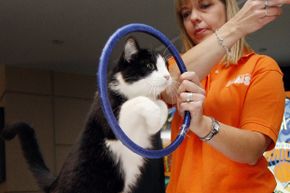
Sit, stay and fetch aren't tricks reserved for man's best friend. Sure, you can teach an old dog new tricks, but, as it turns out, you can teach those same tricks to cats (old or young) -- really. And just like training a dog, training a cat requires patience, practice and a lot of praise and rewards.
Rewarding your cat for a job well done (or a job well practiced, at least) will reinforce the behavior you want, whereas raising your voice or otherwise disciplining your cat will only stress you both out -- and neither of you wants that. Keep your training sessions short (just a few minutes at a time will do) and calm, but also remember: Practice makes perfect. It can take anywhere from several tries to several weeks for your cat, kitten or senior, to learn a new skill, and that will depend on your cat's personality and temperament. Now that you know you can train your cat, let's talk about how to do it; you'll be herding cats in no time.
Advertisement




